Discover these 20 charming tudor style kitchen ideas that are a timeless blend of warmth, charm, and history, offering a uniquely inviting atmosphere that combines rustic elegance with functional design. Imagine stepping into a space where exposed wood beams, intricate stonework, and gothic-inspired fixtures transform the everyday into a scene straight out of a historic English manor. A Tudor kitchen is much more than a cooking area; it's a place where style and nostalgia intersect, bringing a rich sense of character and personality to your home. These elements—dark wood cabinets, arched doorways, brick accents—come together to create a space that feels both intimate and stately, grounding the home in tradition while inviting a sense of comfort and authenticity.
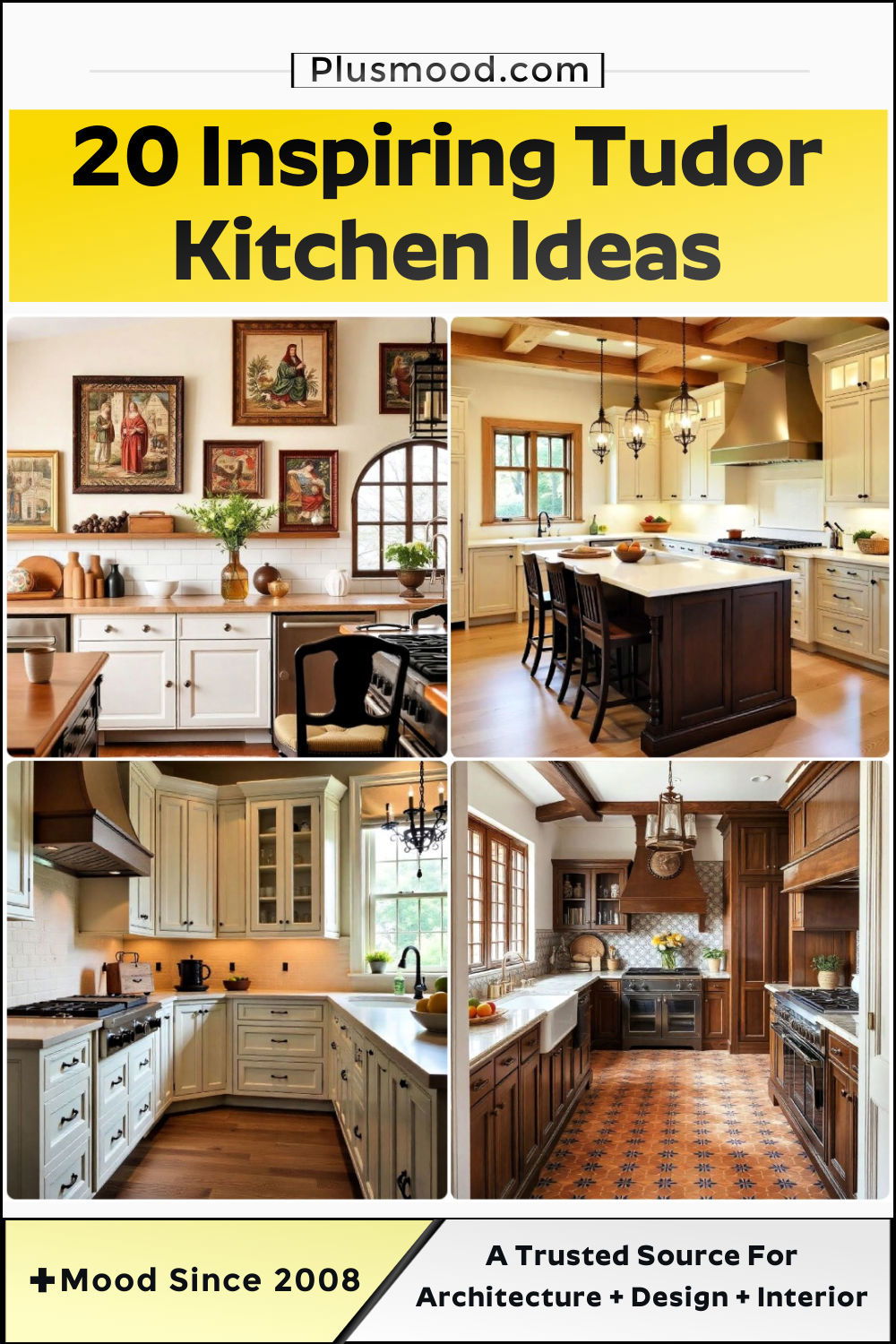
1. Exposed Wood Beams for Rustic Charm
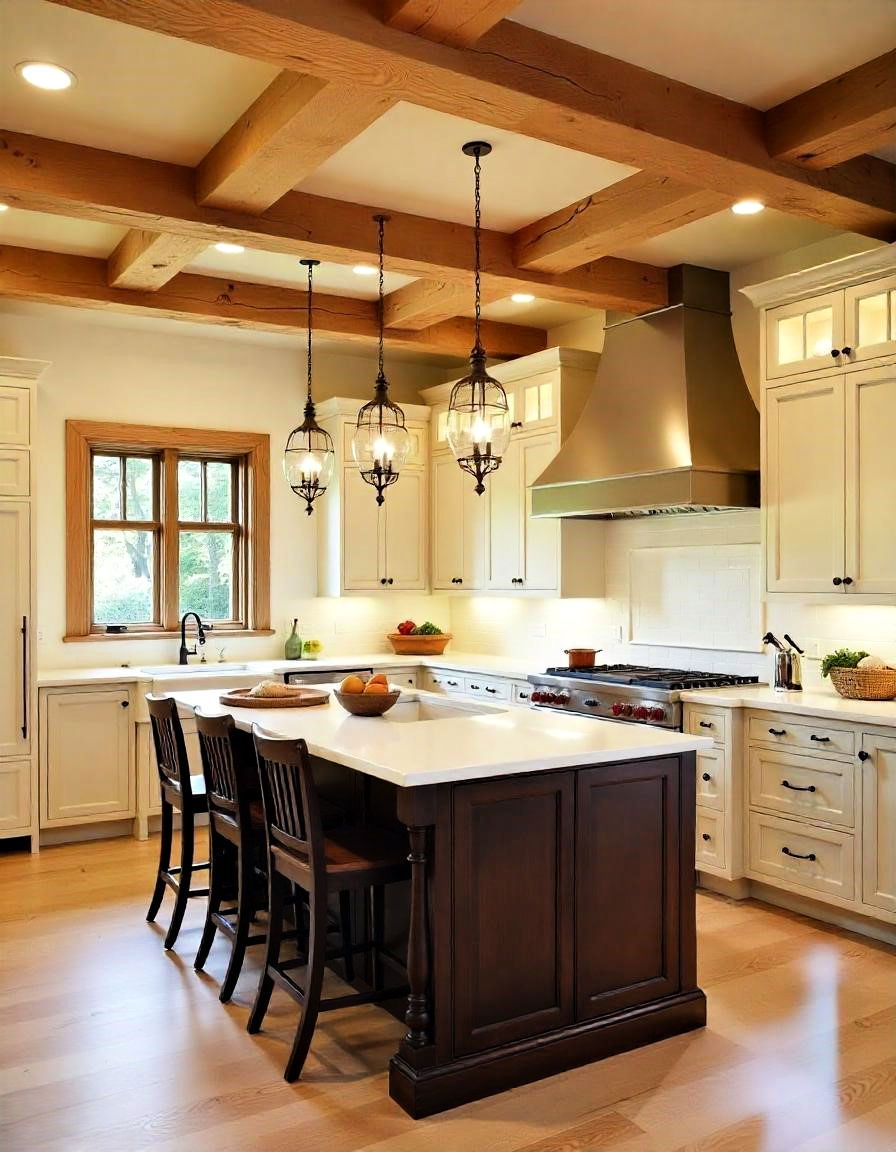
Exposed wood beams instantly add a rustic Tudor charm to any kitchen, evoking a cozy, historical feel. These beams, typically left in their natural or slightly stained finish, give warmth and depth to the ceiling. Whether paired with painted walls or brick, wood beams serve as a structural feature and design statement, transporting your kitchen back to Tudor-era elegance. Complement with wooden cabinetry and traditional fixtures for an immersive experience.
2. Brick Accent Walls for a Historic Touch
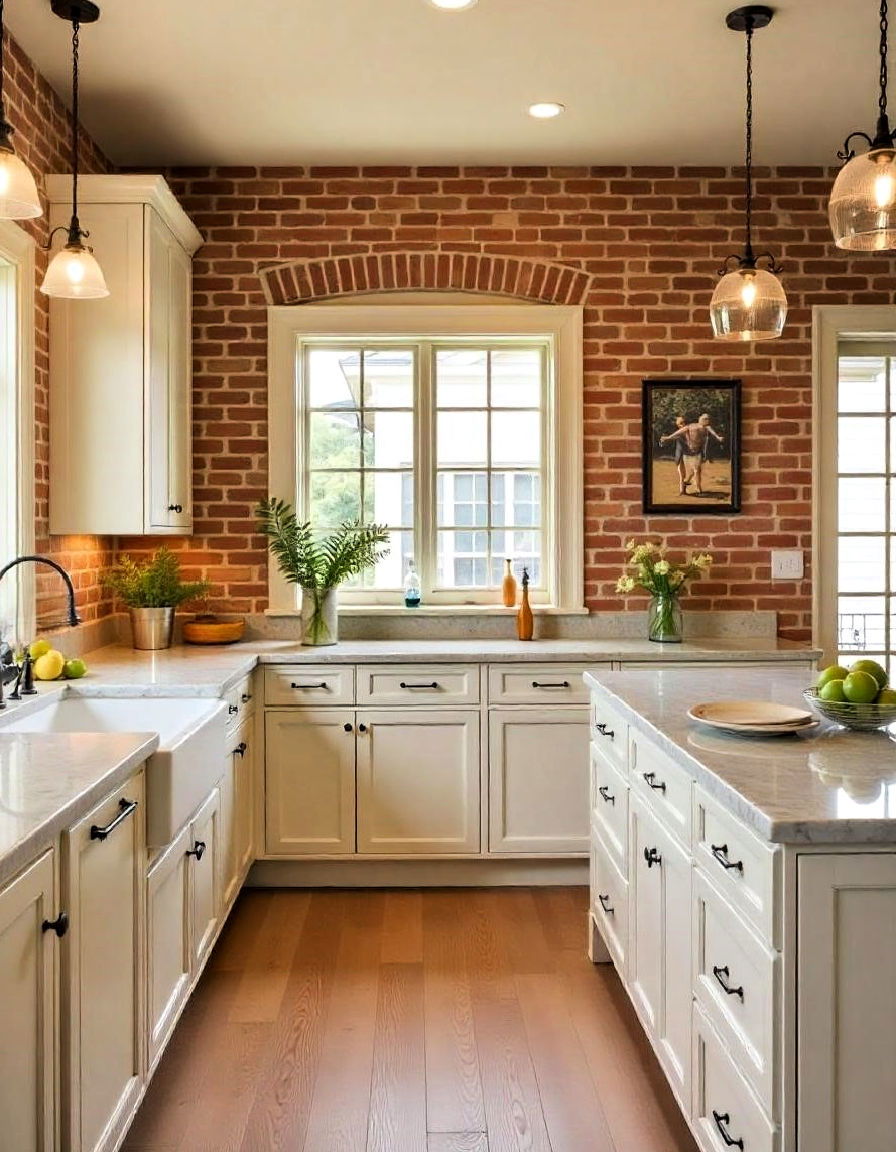
Brick accent walls bring an unmistakable historical element to Tudor kitchens, adding texture and warmth to the space. The rustic, earthy tones of exposed brick blend seamlessly with wooden or wrought iron details, offering a natural contrast to lighter or neutral cabinetry. Enhance the look with antique-style lighting fixtures, creating a timeless backdrop that showcases the charm of Tudor design.
3. Arched Doorways to Capture Tudor Elegance
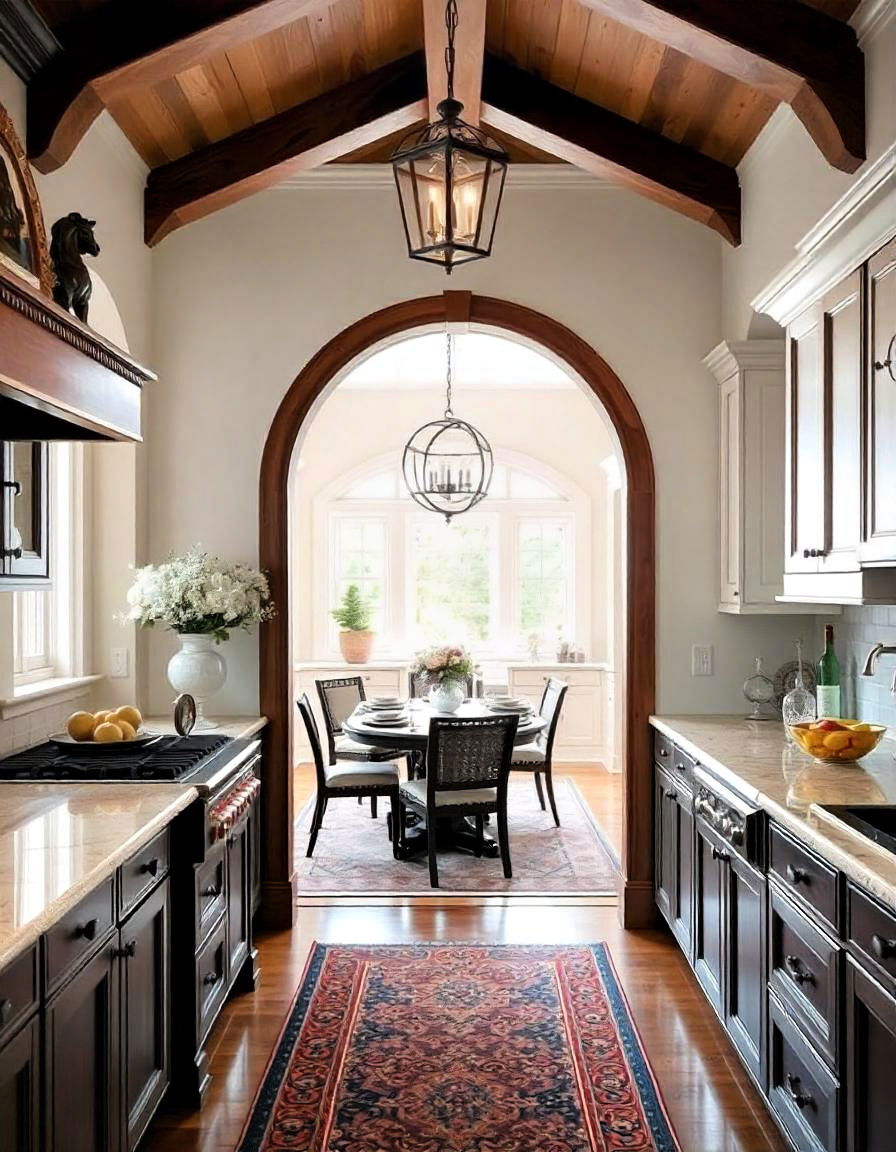
Discover charming Tudor style kitchen ideas for a warm, old-world feel in your home, which can incorporate traditional Tuscan elements. Incorporating arched doorways in a kitchen brings out the quintessential elegance of Tudor architecture. These gracefully curved entrances soften the lines of the room, enhancing its flow and creating a sense of openness. Whether they connect the kitchen to a dining area or lead to a pantry, arched doorways evoke the grandeur of traditional Tudor estates, adding a touch of sophistication that is both subtle and impactful.
4. Dark Wood Cabinets for Authentic Tudor Appeal
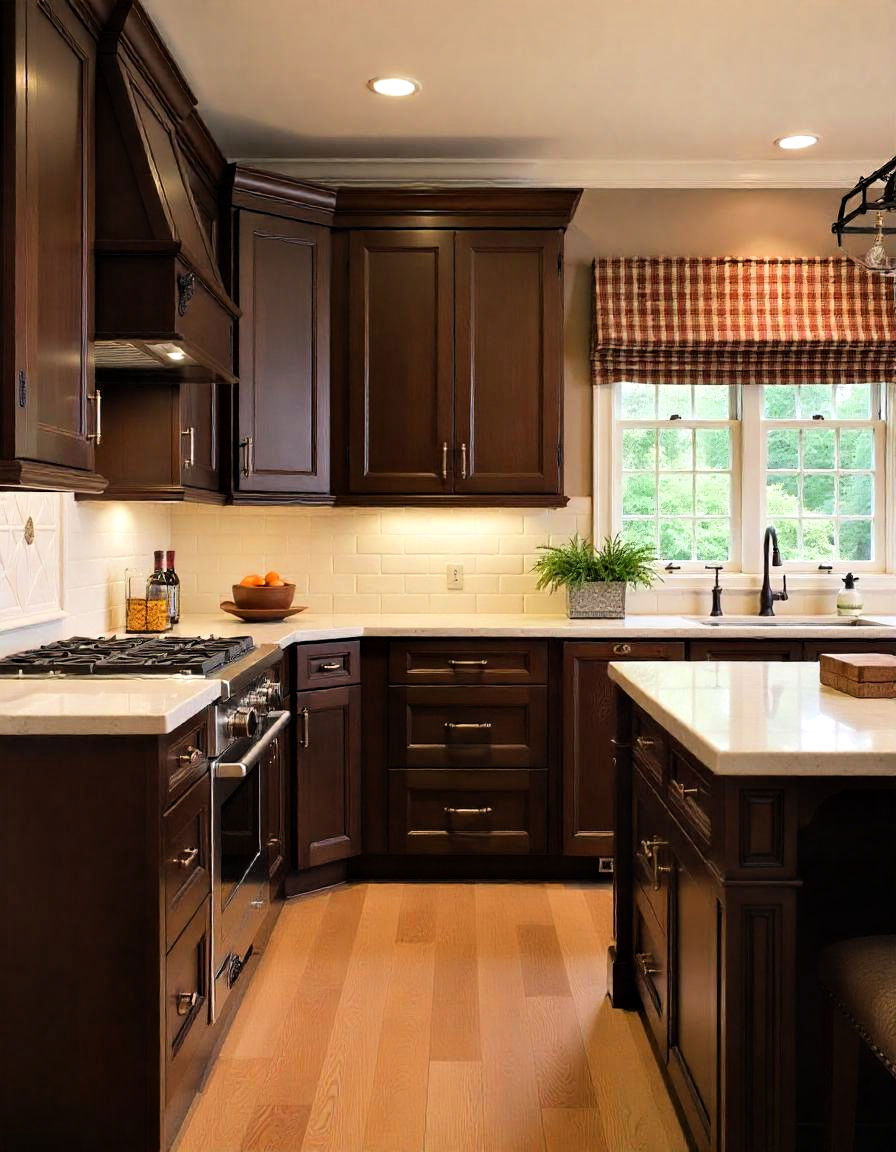
Dark wood cabinetry offers a classic Tudor look, channeling the rich, earthy tones common in historic homes. From walnut to oak, these cabinets add depth and character, making the kitchen feel warm and inviting. To enhance authenticity, consider hand-carved details or antique-style hardware, which pair beautifully with stone countertops and aged metal accents, creating a truly period-inspired space.
5. Cast Iron Fixtures for a Rustic Edge
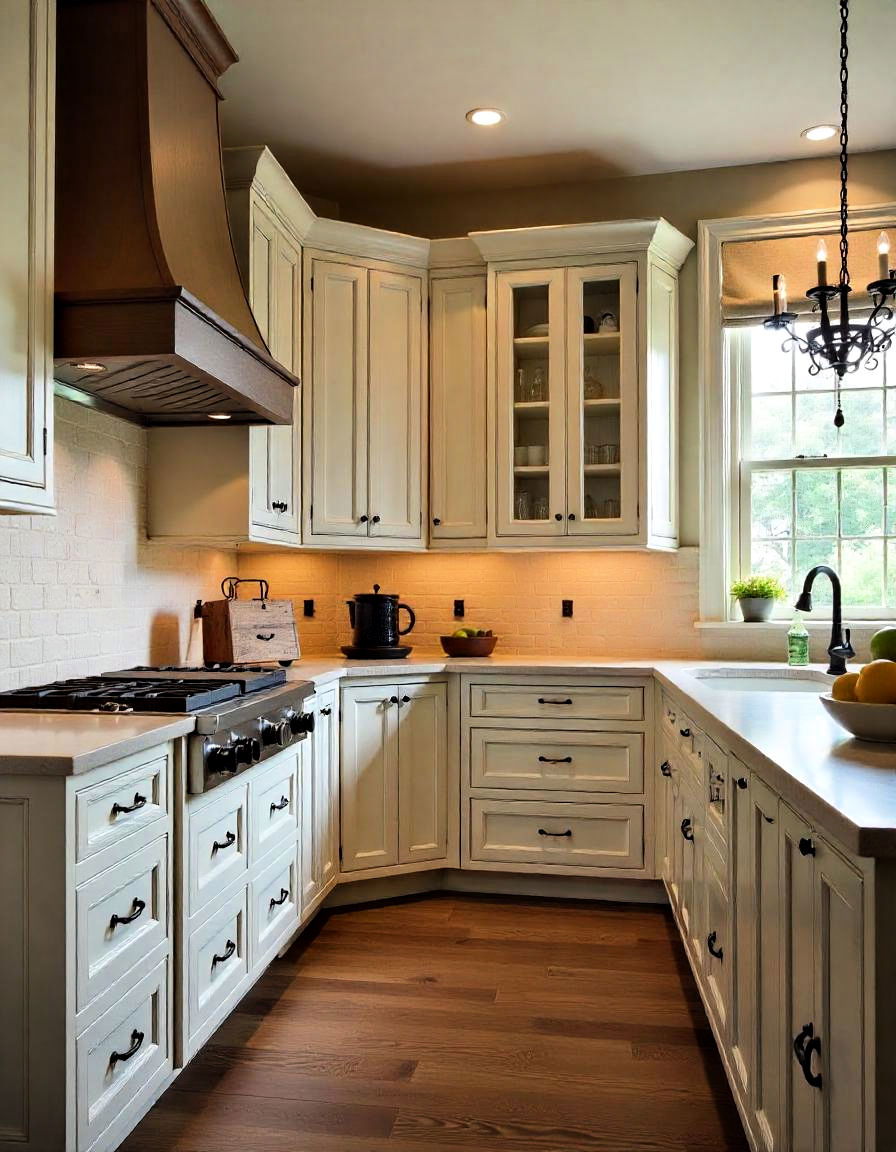
Cast iron fixtures, from cabinet handles to light fixtures, provide a striking contrast against wooden elements, reinforcing the kitchen's Tudor aesthetic. Their robust, textured finish complements the rugged charm of exposed brick or stone, adding an artisanal feel. This material is not only durable but also timeless, ensuring your kitchen remains rooted in traditional style while maintaining modern functionality.
6. Stone Flooring for Durability and Style
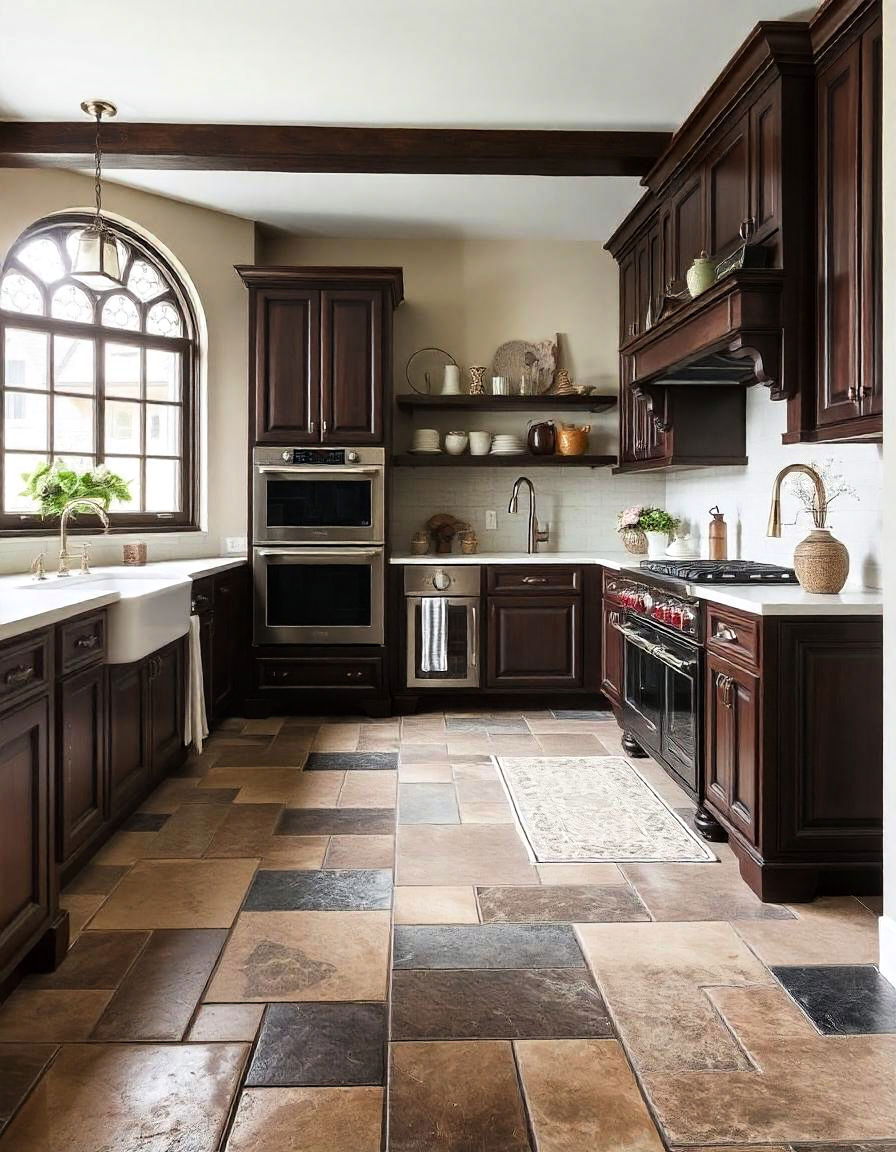
Stone flooring is a practical yet stylish addition to Tudor kitchens, offering durability and an old-world feel. Opt for materials like slate or limestone, which bring natural texture and color variations. Stone floors not only withstand heavy traffic but also age beautifully, developing a patina over time that enhances the kitchen's character. Pair with dark wood cabinetry for a cohesive Tudor aesthetic.
7. Leaded Glass Cabinet Doors for Timeless Elegance
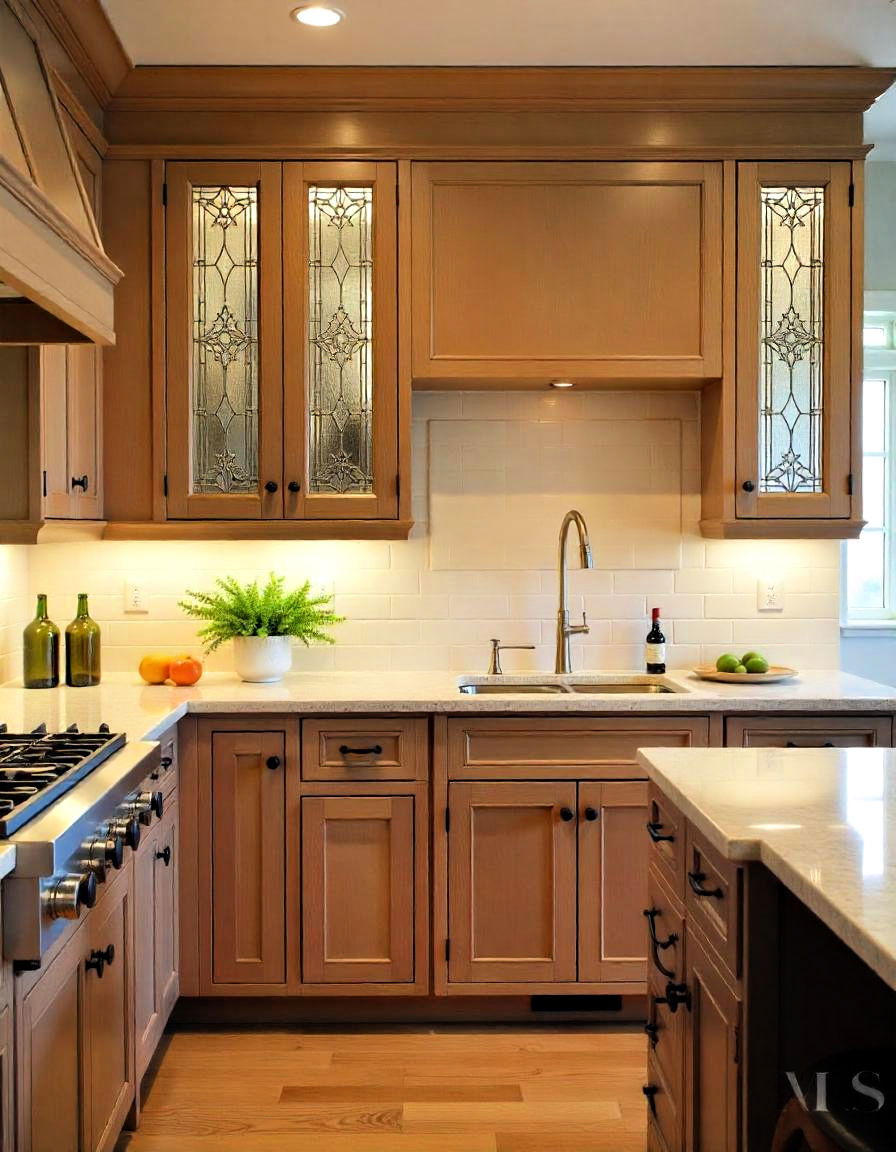
Leaded glass cabinet doors add a refined touch to Tudor kitchens, showcasing intricate craftsmanship and historical style. These doors bring both elegance and lightness, breaking up solid cabinetry with detailed glass panes. The leaded glass reflects light, creating visual interest while providing a peek into cabinet contents. Pair with traditional wood finishes to highlight the timeless beauty of Tudor-inspired decor.
8. Gothic-Inspired Lighting for Drama and Style
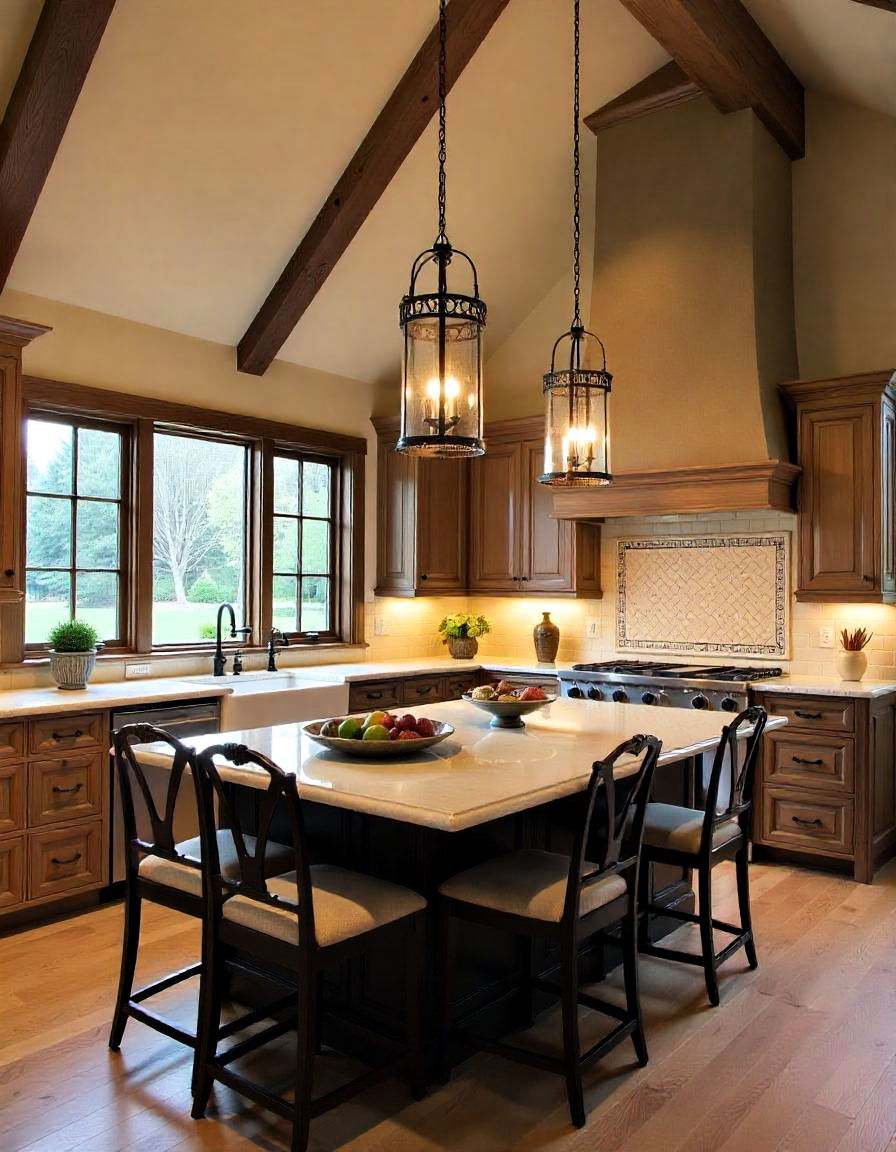
Blend old and new with a modern Tudor kitchen that combines classic elegance with contemporary touches. Gothic-inspired lighting fixtures, like wrought iron chandeliers or lantern-style pendant lights, add a dramatic focal point to Tudor kitchens, blending seamlessly with dining room lighting ideas. These bold fixtures draw the eye upward, emphasizing high ceilings and other architectural elements. Their intricate designs pair perfectly with rustic wood and stone accents, enhancing the kitchen's historic ambiance and offering a hint of medieval grandeur.
9. Tiled Backsplash with Vintage Patterns

A tiled backsplash featuring vintage patterns brings both color and historical appeal to Tudor kitchens, offering inspiration for tile backsplash ideas in other spaces. Choose hand-painted tiles or designs inspired by medieval and early Renaissance art to add visual interest. These intricate patterns add a vibrant touch against the earthy tones of wood and stone, creating a backsplash that's both decorative and easy to maintain, blending modern convenience with classic style.
10. Large Hearth for an Authentic Cooking Space
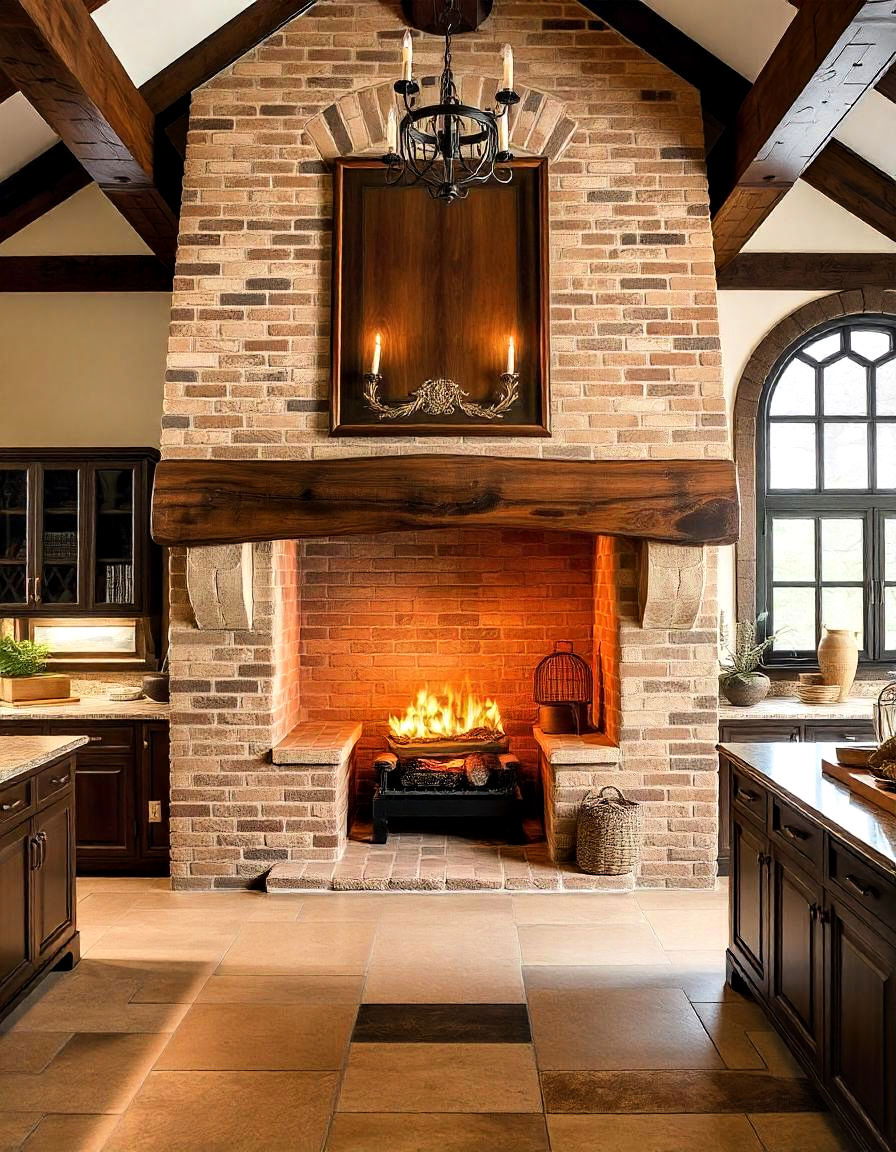
A large hearth makes a bold statement in any Tudor kitchen, reminiscent of traditional cooking spaces. This design centers the kitchen around a grand fireplace, often made from stone or brick, providing warmth and an unmistakable Tudor ambiance. While it may not function as the primary cooking area today, a decorative hearth evokes historical charm, making it a beautiful, nostalgic focal point.
11. Iron Pot Racks for Display and Storage

Iron pot racks not only provide functional storage but also enhance the rustic aesthetic of a Tudor kitchen, fitting seamlessly with other kitchen decor ideas. Hanging these racks above an island or near the stove creates a convenient place for pots and pans while adding to the room's medieval feel. The blackened iron pairs perfectly with dark wood and brick, making cookware accessible while contributing to the Tudor style's utilitarian charm.
12. Window Seating for Cozy Charm

Window seating ideas add a cozy, inviting nook in a Tudor kitchen, perfect for reading or relaxing with a cup of tea. These seating areas bring in natural light, highlighting the kitchen's wood and stone features, and can be softened with plush cushions and throws. Adding storage underneath enhances functionality, creating a spot that feels charming and practical within the Tudor-inspired design.
13. Tudor-Style Range Hood for a Grand Focal Point
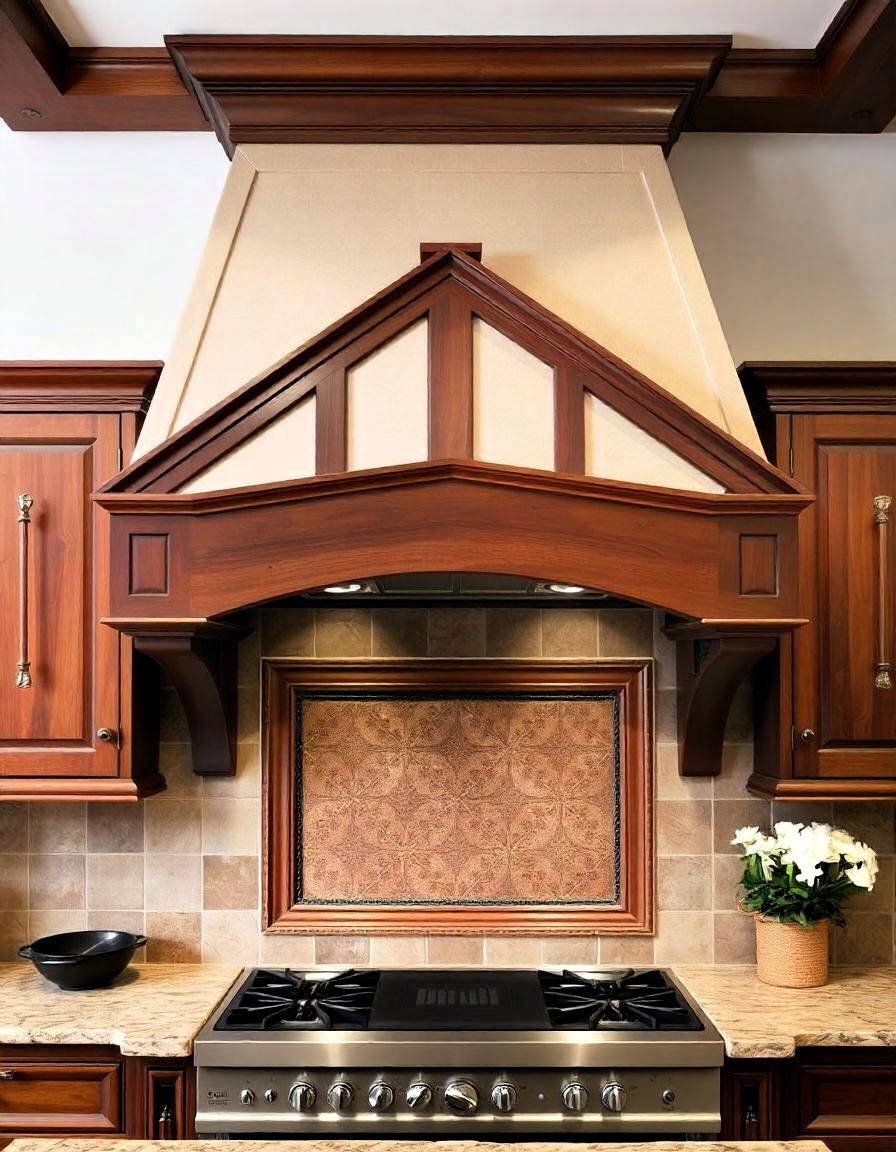
A Tudor-style range hood, crafted from materials like wood or stone, acts as an eye-catching focal point. Often arched or crowned with decorative molding, these hoods blend seamlessly with traditional cabinetry and accentuate the historic feel of the kitchen. This range hood style not only serves its practical purpose but also enhances the kitchen's design, adding grandeur and cohesion.
14. Rustic Farmhouse Sink for Old-World Charm
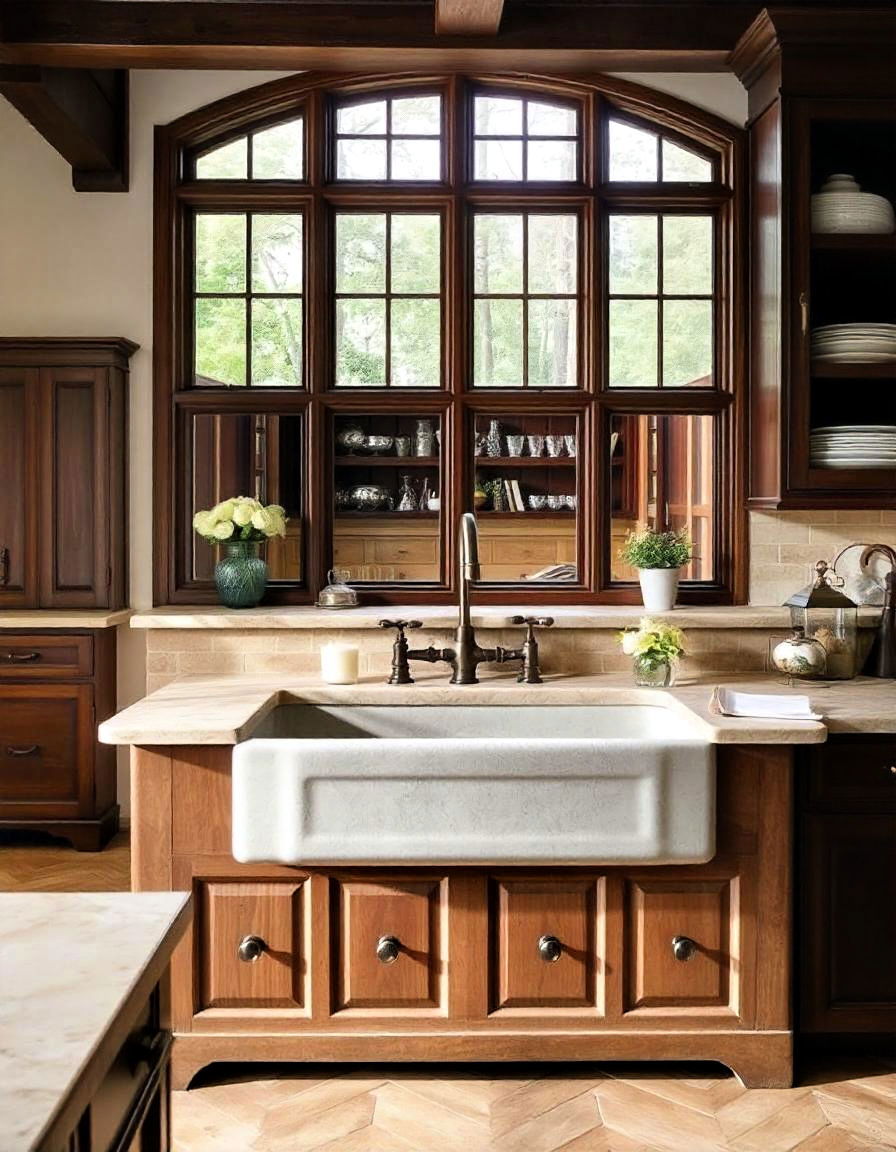
Create a cozy, authentic feel in your kitchen Tudor house interior with traditional wood beams and rich textures. Rustic farmhouse sinks, particularly those made from fireclay or stone, bring a sense of old-world charm to a Tudor kitchen. This deep, wide sink is both practical and stylish, blending perfectly with dark wood cabinetry and stone countertops. Its classic design emphasizes the kitchen's functionality while enhancing the room's historical feel, making it a beautiful centerpiece.
15. Decorative Ceiling Molding for Added Elegance
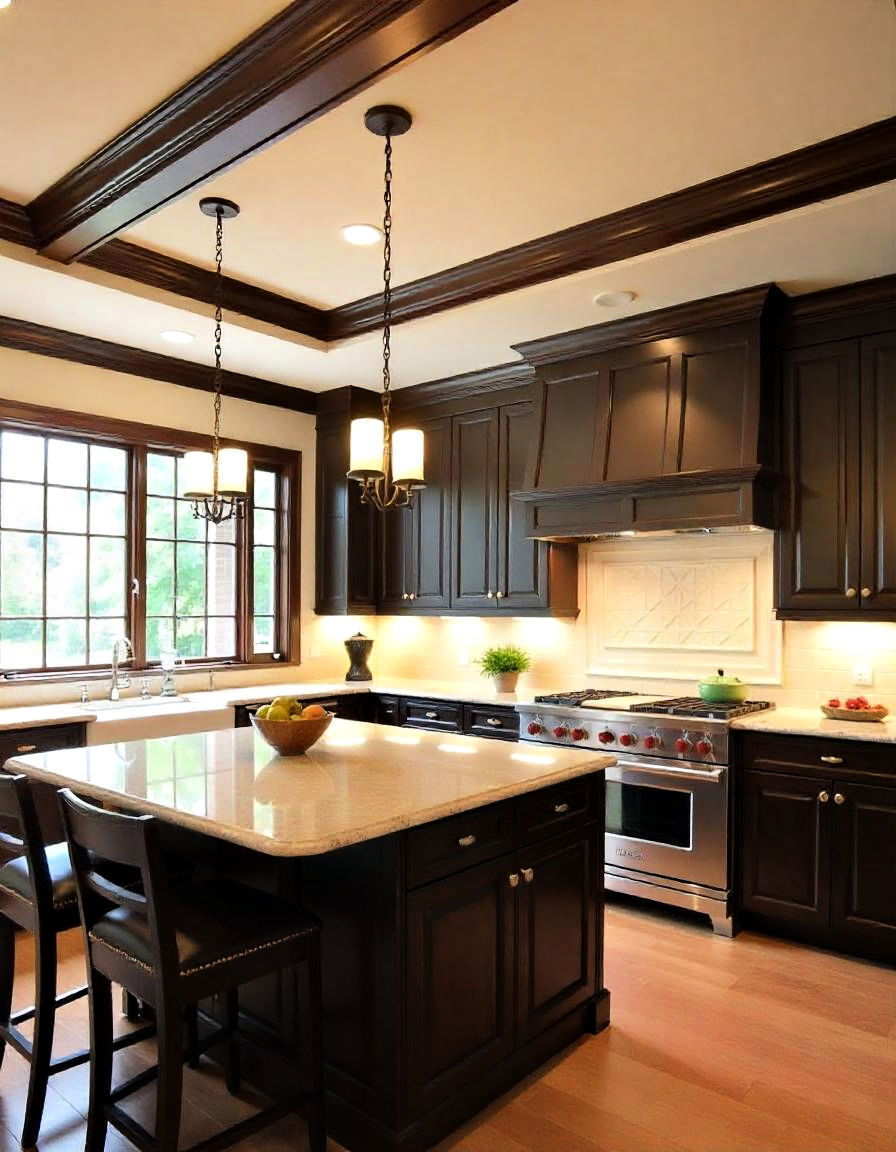
Decorative ceiling molding, such as coffered ceiling ideas, elevates the Tudor aesthetic by adding depth and refinement. From simple beams to elaborate designs, molding enhances the architectural feel of the space and highlights high ceilings. Painted or stained wood moldings blend beautifully with dark cabinetry, giving the kitchen a stately appearance that echoes the grandeur of traditional Tudor homes.
16. Built-In Plate Racks for Vintage Flair

Built-in wooden plate racks provide a unique way to display dishware while adding vintage charm to the kitchen, similar to creative corner shelf ideas. These open shelves showcase plates and decorative ceramics, adding color and personality to the space. Painted in complementary colors or left in natural wood, plate racks bring functionality and beauty, perfect for displaying heritage or artisan pieces that highlight the Tudor style.
17. Butcher Block Countertops for Warmth and Utility

Butcher block countertops introduce natural warmth and durability, similar to wood bathroom floors, making them ideal for a Tudor-inspired kitchen. These wooden surfaces complement dark cabinetry and stone accents, adding texture while providing a sturdy work area. Butcher block counters are easy to maintain and can be refreshed with occasional oiling, ensuring a long-lasting, characterful addition to the kitchen.
18. Wrought Iron Hardware for a Distinctive Look
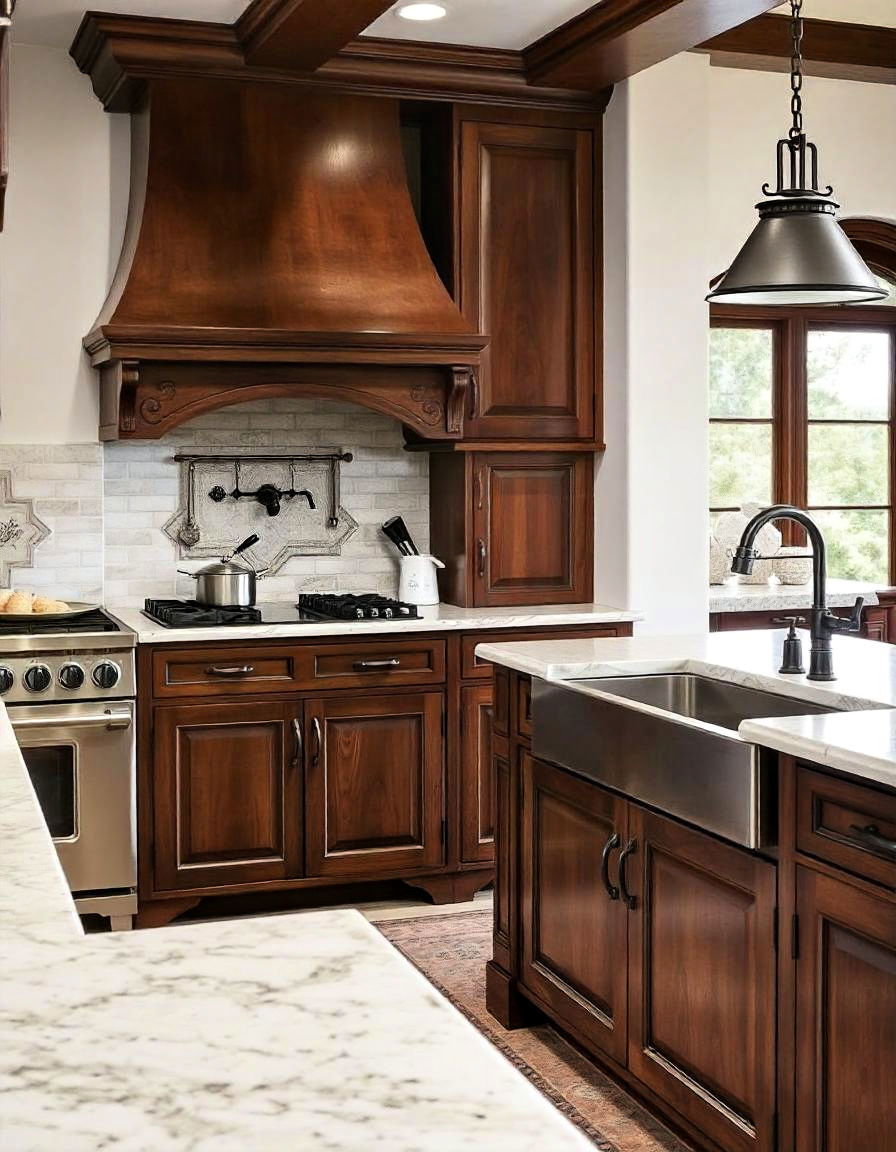
Wrought iron hardware, including handles, knobs, and hinges, adds an artisanal touch to Tudor kitchens. The rugged texture and dark tones of iron create a beautiful contrast with wood cabinets, emphasizing the rustic style. These durable fixtures not only enhance the kitchen's period look but also provide longevity, making them a practical choice for high-use areas.
19. Antique-Style Wall Art for Historical Appeal

Explore timeless Tudor kitchens that feature classic designs and historic English charm. Antique-style wall art, such as tapestries or framed medieval prints, adds a layer of historical appeal to a Tudor kitchen, aligning with traditional wall decor ideas. These pieces evoke the heritage and charm of Tudor decor, giving character to empty wall spaces. Placed thoughtfully, they serve as subtle accents that enrich the room's ambiance, adding a sense of depth and personality that complements the traditional aesthetic.
20. Intricate Tile Flooring for Visual Interest

Intricate tile flooring, especially in patterns like herringbone or basketweave, brings an elegant, historical touch to Tudor kitchens. Choose tiles in warm, muted tones to maintain an authentic look, allowing the pattern to add visual interest without overpowering other elements. This flooring style is not only beautiful but durable, making it a practical choice that resonates with Tudor style's timeless appeal.
Conclusion:
Creating a Tudor kitchen that reflects both style and functionality can be as simple as adding exposed wood beams, brick accents, or gothic lighting fixtures. Each of these elements combines to capture the essence of a Tudor-style kitchen, offering warmth and authenticity while standing the test of time. With ideas like stone flooring, rustic cabinetry, and vintage touches, you can transform your kitchen into a space that celebrates heritage, elevating it with timeless elegance and a distinct historical flair. Whether you're adding antique-style wall art or choosing dark wood finishes, every detail contributes to the unique, old-world charm of a Tudor-inspired kitchen.
Key Points:
- Historic Ambiance: A Tudor kitchen design embraces historic elements like exposed wood beams, dark wood cabinetry, and brick accents, creating a warm, timeless atmosphere.
- Rustic Materials: Core materials include stone for flooring and countertops, iron for fixtures, and leaded glass for cabinetry, which together highlight Tudor architecture's enduring elegance.
- Statement Details: Arched doorways, intricate molding, and gothic-style lighting serve as dramatic focal points that define the Tudor style.
- Functional Vintage Elements: Features like built-in plate racks, butcher block countertops, and farmhouse sinks add practicality while reinforcing the historical aesthetic.
- Unique Accents: Wrought iron hardware, antique wall art, and patterned tile floors bring character and reinforce the design's heritage feel.
What to Do Next:
- Start by selecting key Tudor-inspired elements, like dark wood cabinets or stone flooring, that fit your space and budget.
- Focus on creating a cohesive look by combining rustic materials like iron, stone, and wood.
- Incorporate focal points such as gothic lighting or a vintage-style range hood to emphasize the Tudor aesthetic.
- Add subtle vintage accents, such as leaded glass cabinets or wrought iron hardware, to complete the look with historical charm.
- For a more immersive design, consider adding arched doorways or decorative ceiling moldings to capture Tudor architecture's signature style.

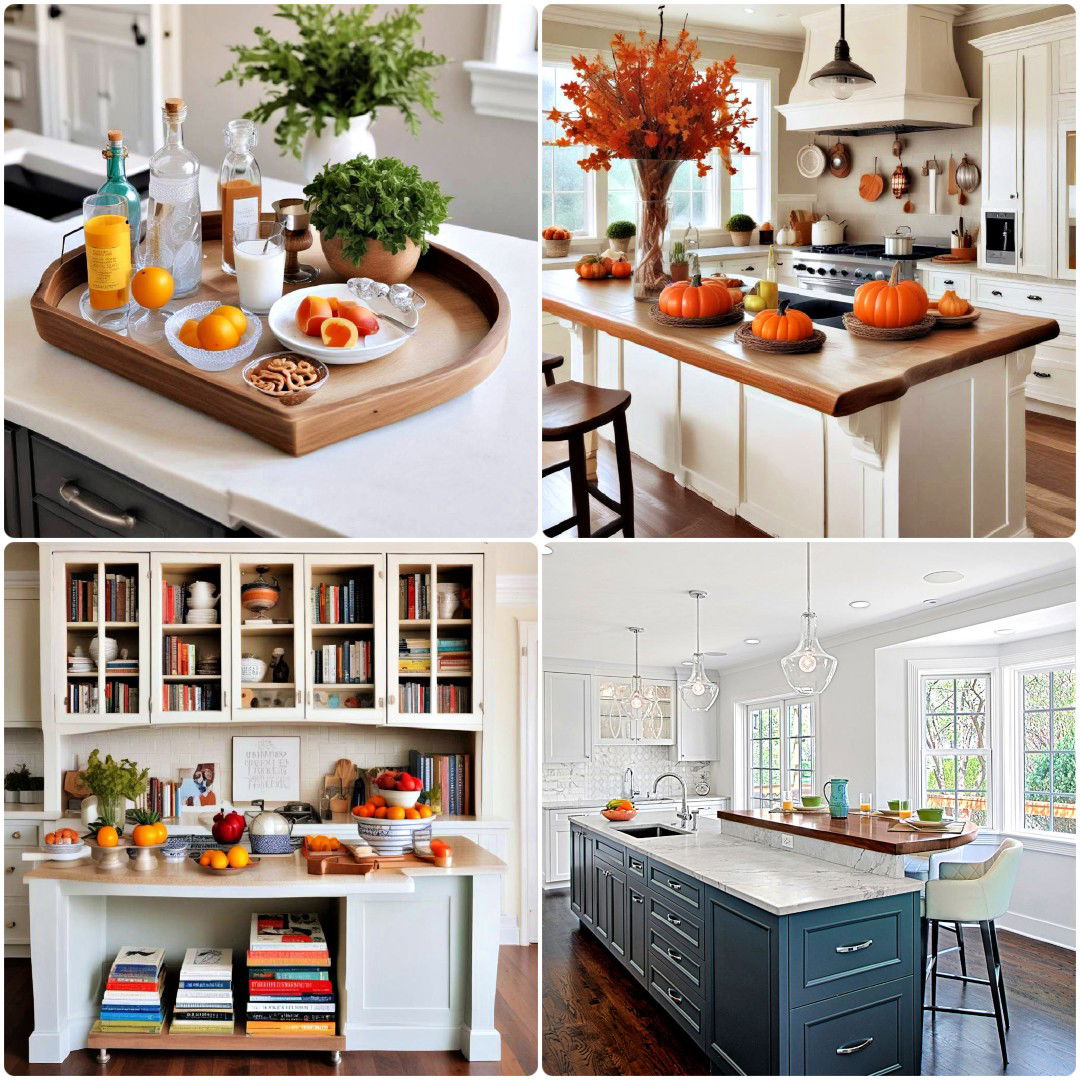
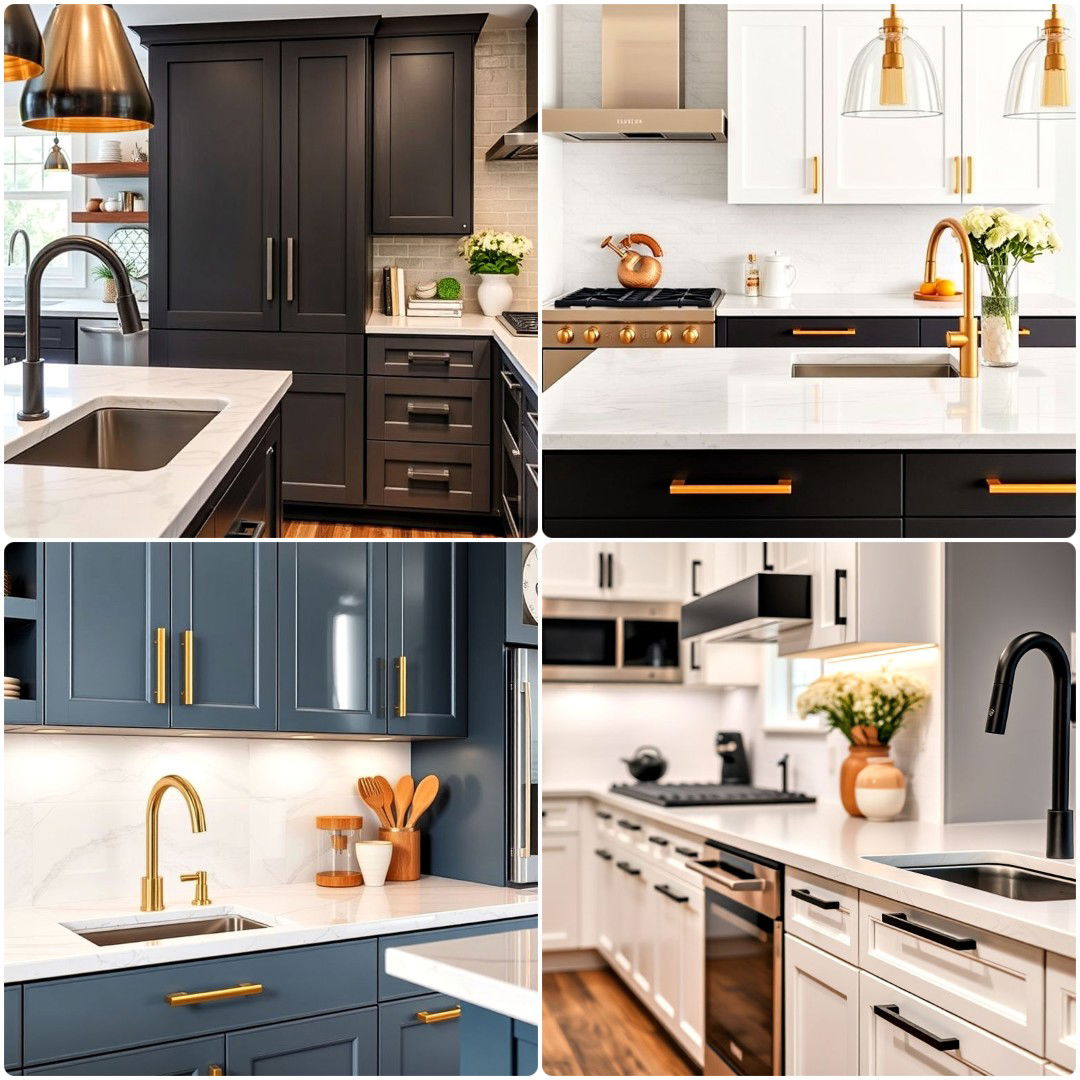
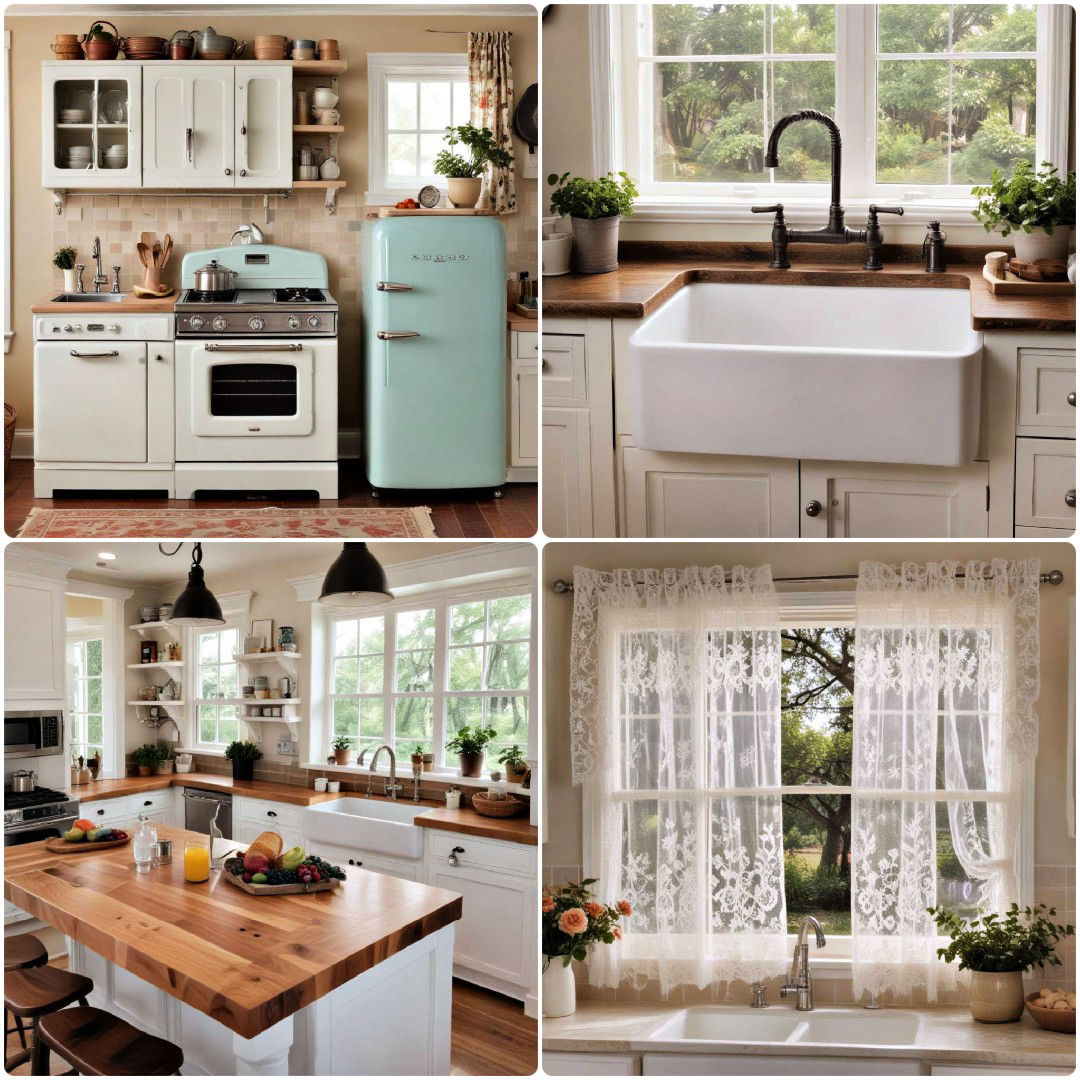
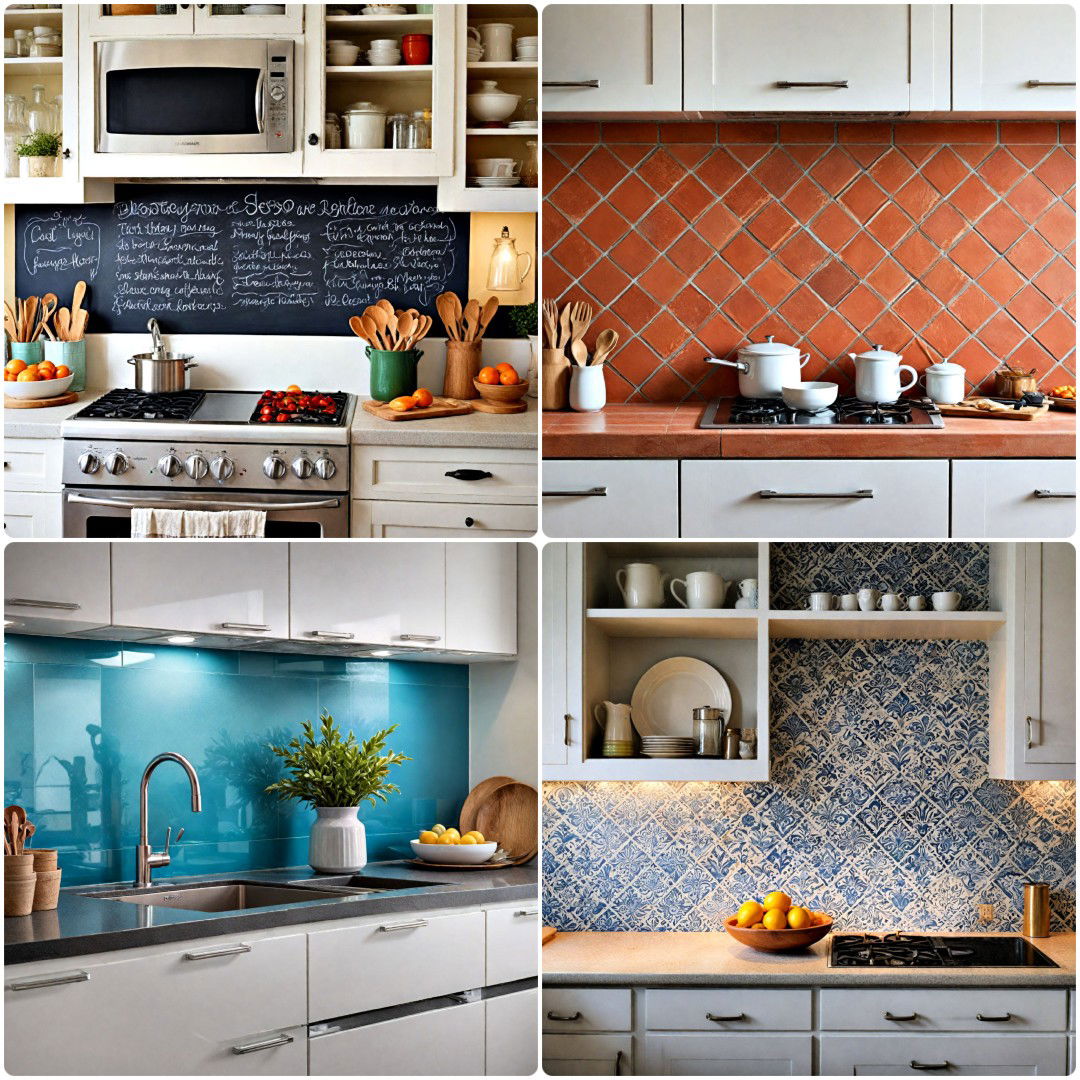
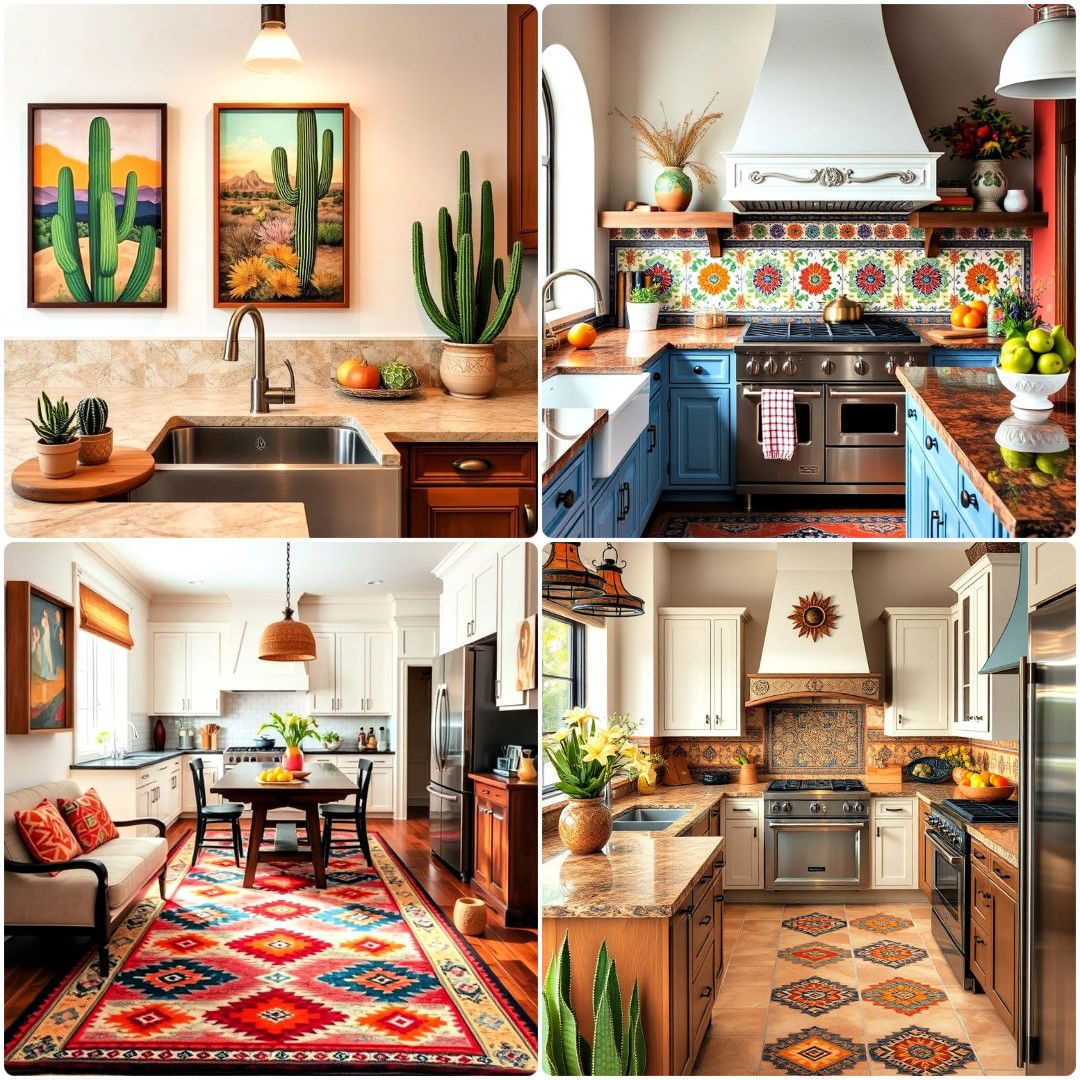
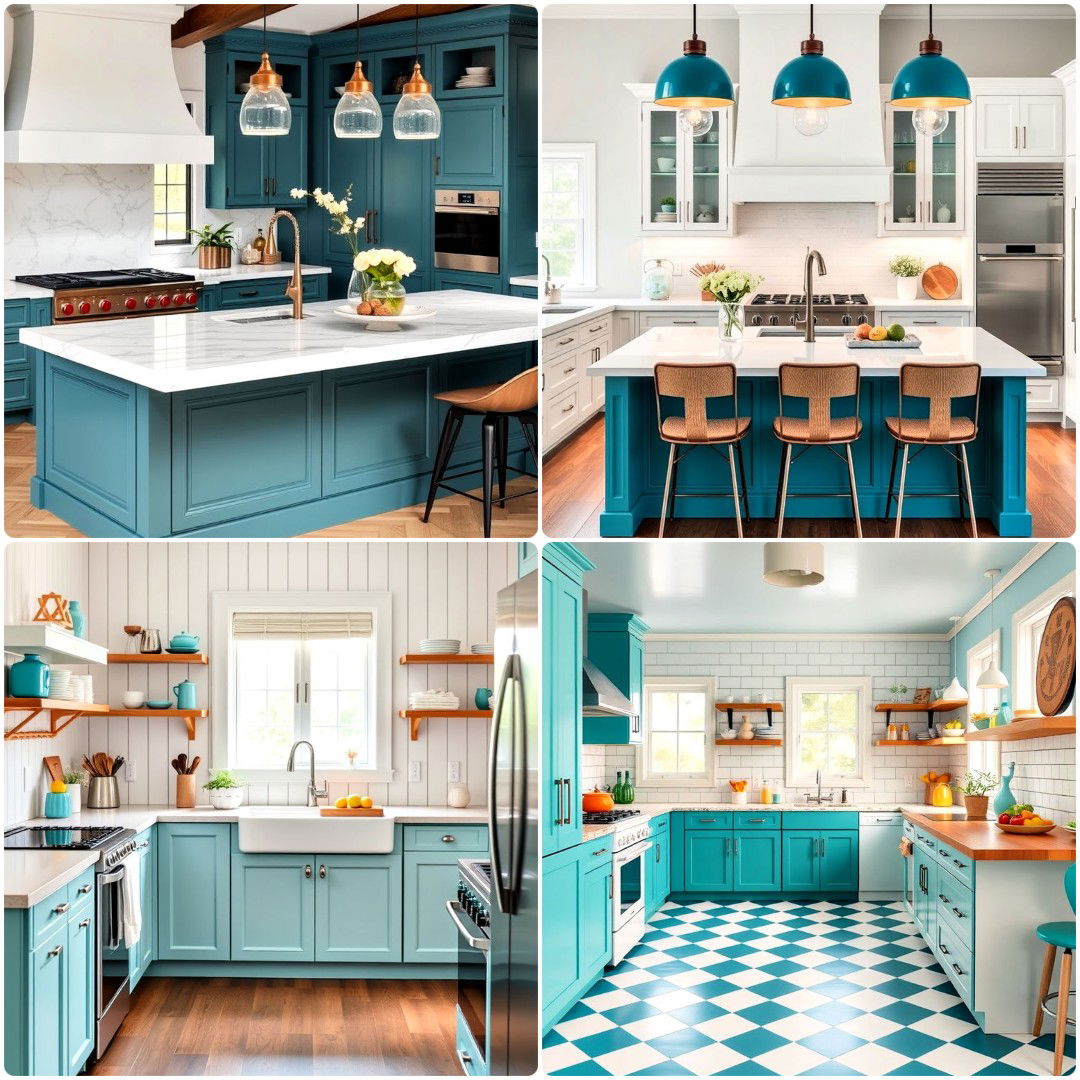
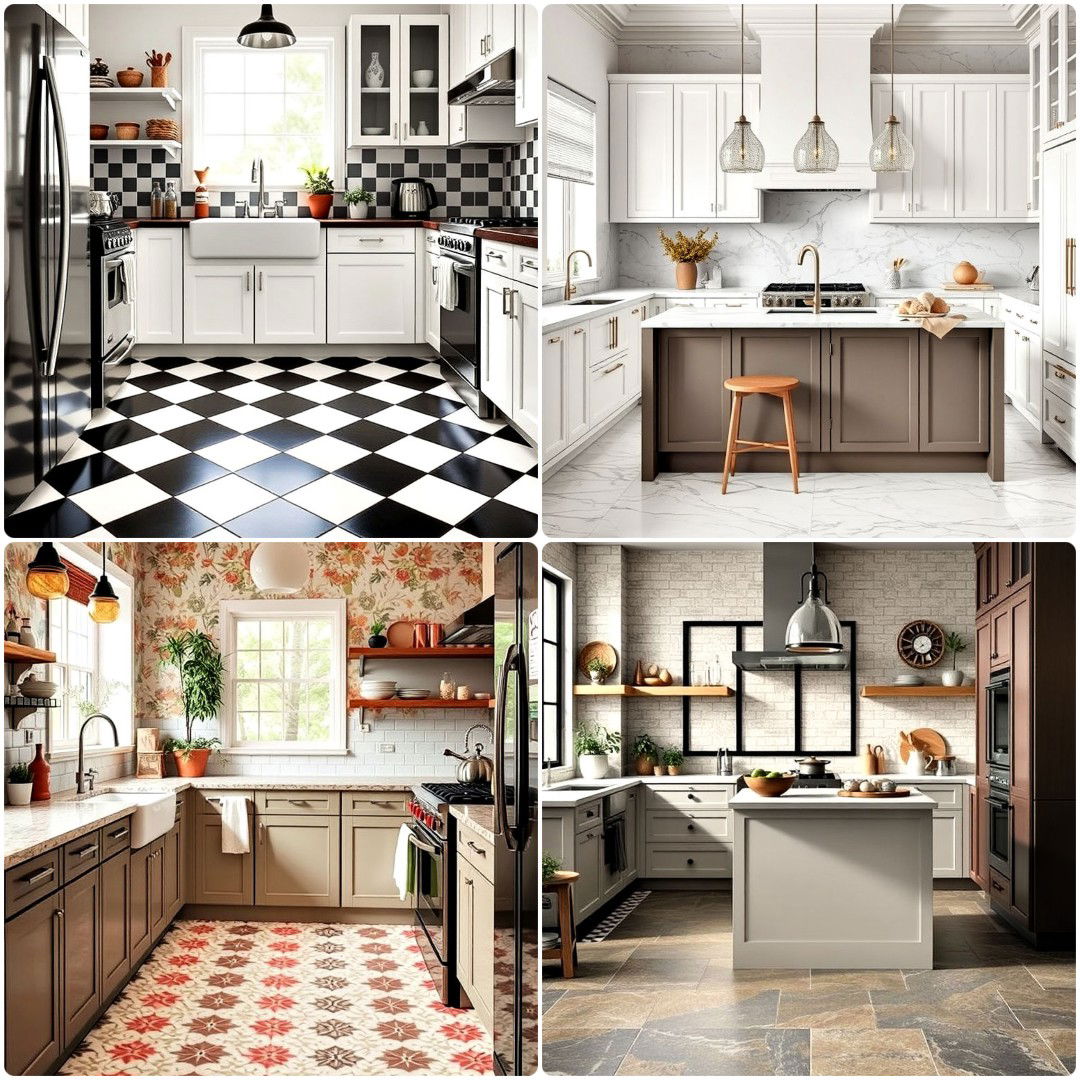
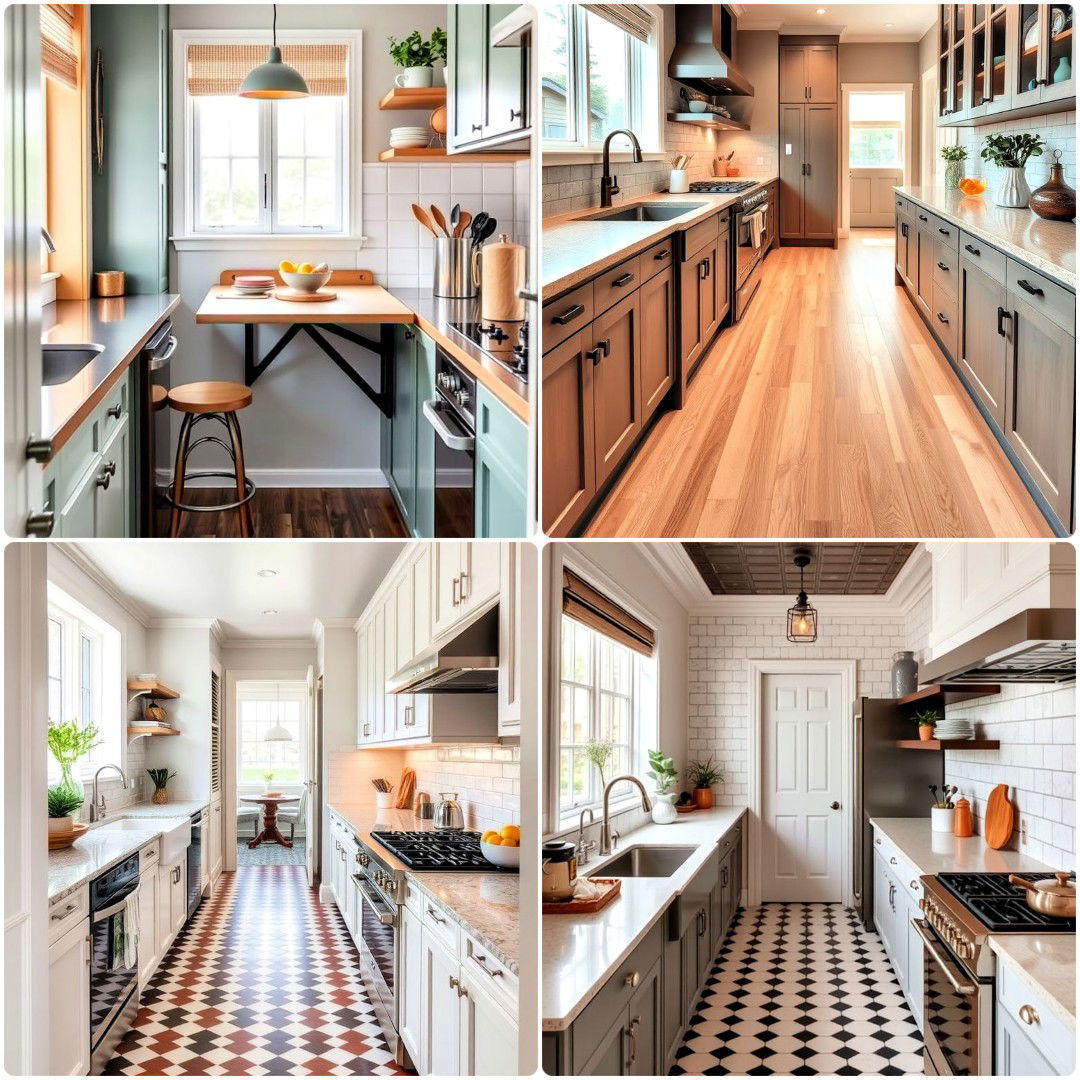
Leave a Reply